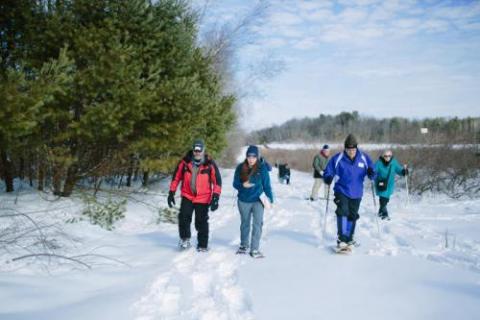On a chilly Saturday morning in February, over 30 volunteers strapped on their snowshoes at the Great Bay National Wildlife Refuge to search for rabbits. Three days after a blanket of snow dropped on Southern New Hampshire, it was the perfect time to look for tracks and pellets – the telltale signs of rabbit presence. These citizen scientists are helping NH Fish and Game and UNH Cooperative Extension learn more about where eastern cottontails are found in New Hampshire.
The eastern cottontail rabbit was introduced to New England as a game species in the early 1900s, and is now the dominant rabbit in New Hampshire. Eastern cottontails are better able to survive in fragmented, human dominated landscapes than the native, state-endangered New England cottontail.
New England cottontails require large (>5 acres), unfragmented areas of shrubland habitat and, in part because this habitat type is lacking on the landscape, the range of the species has shrunk by more than 85% over the last several decades. We currently have less than 100 individual New England cottontails in New Hampshire.

UNH Cooperative Extension's Haley Andreozzi leads a group on a survey. Two other groups surveyed other parts of the refuge for cottontails.
The two rabbits look nearly identical. Both species remain brown year-round, unlike the relatively common and much larger snowshoe hare, which turns white in winter. The eastern cottontail has slightly larger ears and eyes, but these subtle differences are difficult to differentiate in the field. Because their pellets also look the same, biologists have to use DNA analysis of the rabbit droppings to identify which species is present in an area. Collecting pellets in southern New Hampshire, where the two species overlap, helps biologists understand where eastern cottontails occur, their abundance, and potential threats to New England cottontails. Since pellet surveys are intensive and the area to search is large, UNH Cooperative Extension and NH Fish and Game train volunteers each winter to help with the search.
While exploring the refuge in groups to practice surveying for eastern cottontails, signs of other wildlife appeared in the snow. Tracks from red fox, fisher, meadow vole, and raccoon zigzagged in and out of the trails the volunteers followed. For two groups, a series of rabbit tracks led the way to pellets. They followed the collection instructions, filled out a data sheet, and brought the samples back to submit for DNA analysis. We won’t know what species was present until the analysis is completed. Volunteers went home with supplies to collect samples on their own following the training. These efforts contribute valuable data to improve our understanding of rabbits in New Hampshire – one pellet at a time.

Volunteer-in-training Lee Pollock found the pellets and did the honors of gathering the sample, which will be analyzed at the University of New Hampshire to determine which species of cottontail it's from.
To join in the search for rabbit pellets next winter, contact Haley Andreozzi, UNH Cooperative Extension, Wildlife Program Outreach Coordinator at haley.andreozzi@unh.edu. Stay tuned for a new citizen science project from NH Fish & Game and UNH Cooperative Extension – NH Rabbit Reports – where anyone can submit information on rabbit sightings in New Hampshire; the project launched in summer 2017.


